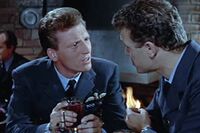Passive drinking
Passive drinking refers to the many ways in which a punter can become drunk other than actually ingesting, swilling, or chugging liquids — which is active drinking. Passive drinking is a large problem at pubs and bars all over the world, at which patrons stare at wine glasses or beer mugs, slowly being overcome and losing their inhibitions (and clothing) as the result of poison spewing out from what society views as 'safe drugs'.
How it works[edit]
Booze includes many intoxicating chemicals such as alcohol, hops, yeast, sugar, malt, barley and water. Though sugar is intoxicating (leading to the sugar high), it rarely results in consequences such as embarrassing texts that make people want to steal and destroy other people's cellphones.
When alcohol comes into contact with the skin, it can leach through the epidermis though reverse osmosis. Once the alcohol has passed into the skin, it enters the bloodstream, through small capillaries in the skin used to give off heat. Generally, places used to drink alcohol are bars, pubs, and nightclubs, which are warm. As a result, the alcohol can enter though the capillary walls into the bloodstream. Many volatile drinks do not require the drink to be spilt but simply enter the eye and skin from the air.
Short-term effects[edit]
The results of second-hand alcohol are similar to drinking. The affected person begins to lose concentration over the course of several hours. In areas of high drink spillage, the person starts to lose balance, and the verbal abilities he surely had on entering the establishment, and is soon unfit to drive because of impaired judgement. In extreme cases, people have jumped from cliffs and tall buildings in an attempt to fly. One such person forgot he needed to fall and asked for directions from Google on the way down.
Long-term effects[edit]
Passive drinking over time can result in a phantom beer belly (extreme phony weight gain), fatuous deposits in the liver resulting in imagined damage. Beer causes the destruction of brain cells which are unable to be regenerated or regrown, despite the lack of the damage experienced by active drinkers.
A drinker’s brain is almost worthless in teaching anatomy. However, medical professors are careful to distinguish active and passive drinking. A drinker's brain is pickled by long-term absorption of fluid from fancy bottles. A passive drinker's brain on the other hand is physically as dry as dust when dissected. Surgeons have long recognised that passive drinking can do this to you.
Aversion therapy[edit]
In common with hard drugs, weaning people off Passive Drinking involves charities and do-gooders. It's bad enough with people who are suffering from alcoholism to then have another tranche of those claiming Passive Drinking problems. The more radical in the medical community suggest a holiday in the Islamic State as one-way cure for anyone with drinking problems - active or passive.
Second-hand alcohol[edit]
Some people believe that spilt beer and alcohol cannot enter the body through the skin and that many effects are simply the effects of drinking the alcohol. Other people think that the effects of passive drinking are grossly underestimated and that passive drinkers are a greater risk to public health than chronic sots.


